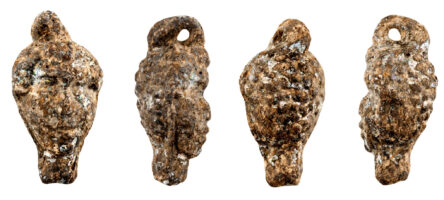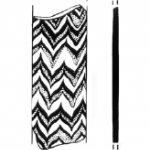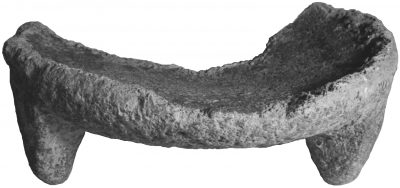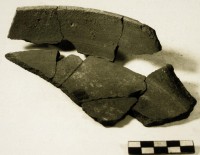
considerations of the specialized terms and categories that archaeologists use

BD 89 is a small glass pendant in the form of a black African male head. It dates to c. 100 BCE, a time when pendants of this subject and style were common throughout the eastern Mediterranean.[1] All share features characteristic of a black African male: dark purple or black coloration; a wide nose and lips; and curly hair.[2]
The meaning of these pendants remains a matter of speculation. Artisans purposefully crafted a detailed human subject endowed with distinct physical characteristics.[3] The uniformity suggests a consistent conceptual starting point, and perhaps therefore a shared purpose. Possible reasons were to evoke curiosity and wonder for ‘exotic’ and distant cultures or places, presumably through a viewer’s unfamiliarity with such physical characteristics. Wearing a pendant such as this may have lent its owner an aura of worldliness, knowledge of and connection to foreign regions.
Viewing these pendants from a modern perspective is more complicated. A contemporary lens may regard depictions of race and ethnicity with caution since exaggeration or manipulation of physical difference can be a catalyst for harmful and antagonistic stereotypes. In this case, the pendant’s accentuated physical characteristics are purposeful, meant to categorize its subject as ‘other’ or distinctly “not Greek.”[4] This intentionality creates a tension, between honest fascination or curiosity with the unfamiliar, on the one hand, and on the other hand generalization or racialization of an entire ethnic group. In form and subject, this pendant reflects the complexities for individuals living in this era of comprehending new people, places, and cultures. As an item of personal adornment, the African Head pendant reflects its owner’s acknowledgement of and interest in expanding his or her known world. As a deliberately ‘othering’ object, perhaps it also helped them distinguish their place within that world.
[1] Larson, “Personal Adornment: Glass, Stone, Bone, and Shell,” in TA II, iii, p. 114
[2] Larson, in TA II, iii, p. 114-116
[3] Larson, in TA II, iii, p. 112-114, 116-118
[4] Larson, in TA II, iii, p. 116

Archaeologists identify vessels with this specific shape as alabastra (the Greek plural form of the singular alabastron). The form—a long cylindrical body with a round-bottom—was common among ancient glassmakers; it copies a shape that would have been familiar from objects made in other materials, including ceramic and, especially, alabaster – hence the name alabastron. Other shapes of ancient core-formed glass vessels also imitate ceramics, metalwork, and stone, and like alabastra they too have names derived from Greek and Latin terms, such as amphoriskos or phiale.[1] Yet these names are modern conventions, employed by scholars to categorize and identify groups of similar objects for ease of analysis and discussion. As David Grose points out in his chapter on the glass from Tel Anafa, “the original terminology used by ancient peoples for specific forms and functions of common table wares … are mostly unknown or virtually unknowable.”[2] We have lost that part of the past.
[1] C.S. Lightfoot, “The Pendant Possibilities of Core-Formed Glass Bottles,” Metropolitan Museum Journal 36 (n.d.): 59–66; Grose 1989; Grose 2012.
[2] Grose 2012, 14.

Stone tools are especially durable and the same shapes were used for long periods of time, which complicates the task of dating their use. This is especially true for objects used in food production, such as this tripod grinding bowl.[1] The catalog entry tells us that it was recovered in a stratum dating to the Roman 1A period (c. late first century BCE – early first century CE) – but, like many items, it was uncovered in a secondary context. What this means is that the Roman 1A phase is the latest possible date; it may have originally been made and used in earlier times. To learn more, we have to look up its exact find location (in the locus summary from the first volume of the site’s final reports). This is locus 21104 in trench 2.11, a fill just above the Late Hellenistic settlement but beneath the level of the early Roman habitation.[2] Thus this grinding stone had been used by the site’s Late Hellenistic residents, and by Roman period it was one hundred year old trash hiding beneath the occupants’ feet.
[1] Wells et al. in TA II, ii, p. 317.
[2] Herbert in TA I, i, p. 51.

Andrea Berlin, the archaeologist who wrote the catalogue entry for this terra cotta baking dish, recorded its color as “bright orange (2.5YR 6/8).”[1] While the verbal description “bright orange,” is essentially a subjective interpretation, the parenthetical notation “2.5YR 6/8” is a precise, quantifiable, scientific designation. This designation refers to a specific color chip listed in the Munsell Soil-Color Charts, which archaeologists use to record the colors of soil layers and artifacts made from earthen materials. The charts emerge from the work of American painter and art teacher Albert Henry Munsell (1858-1918), who developed a method of systematically communicating color. Munsell based his system on how colors are perceived, using three different properties: hue (a specific color), value (a measure of how light or dark the color is), and chroma (the intensity of the color). Specialized versions of Munsell’s system—like the Soil-Color Charts developed by the U.S. Department of Agriculture—are widely used in the sciences.[2] For this pan, “2.5YR” indicates a hue that is 2.5 steps along a yellow-red spectrum; the value “6” locates the color on the lighter end of the chart; and the chroma “8” gives it high intensity. There you have it: “bright orange,” scientifically quantified.
[1] Berlin in TA II, i, p. 106.
[2] For an overview of Albert Munsell’s development of his color system, see Edward R. Landa and Mark D. Fairchild, “Charting Color from the Eye of the Beholder: A Century Ago, Artist Albert Henry Munsell Quantified Colors Based on How They Appear to People; Specializations of His System Are Still in Wide Scientific Use,” American Scientist 93, no. 5 (2005): 436–43.
